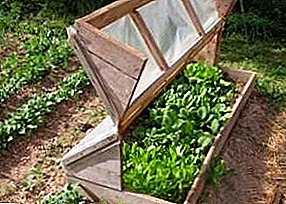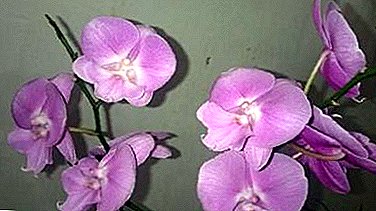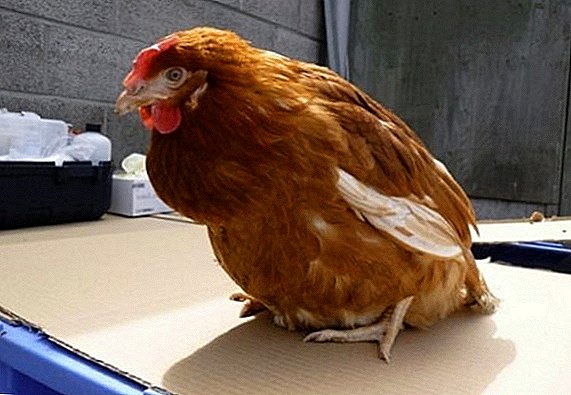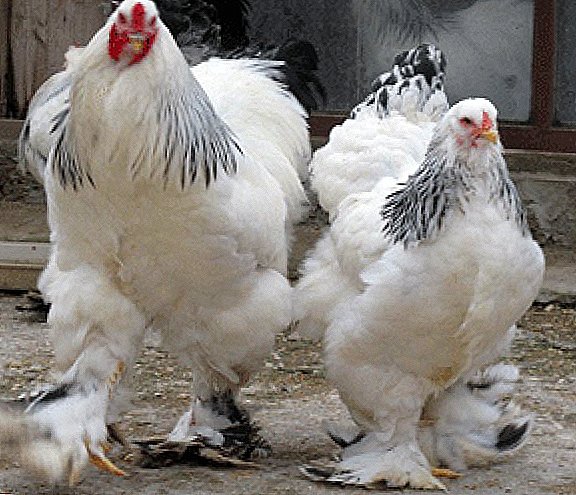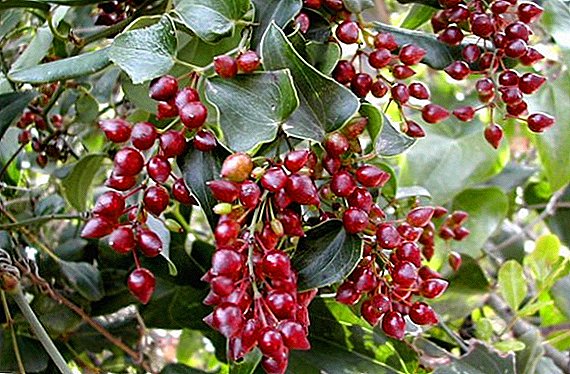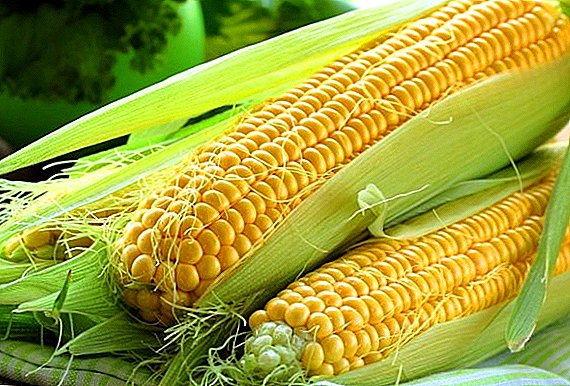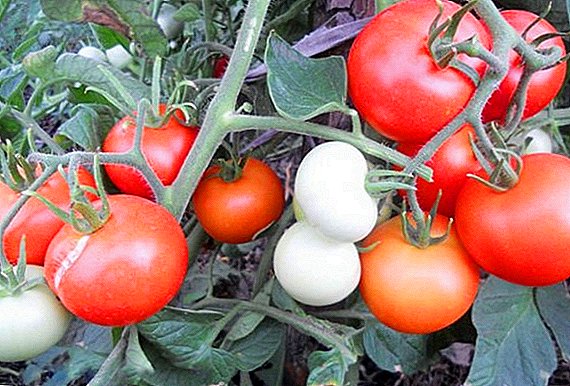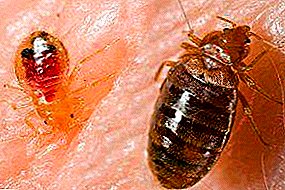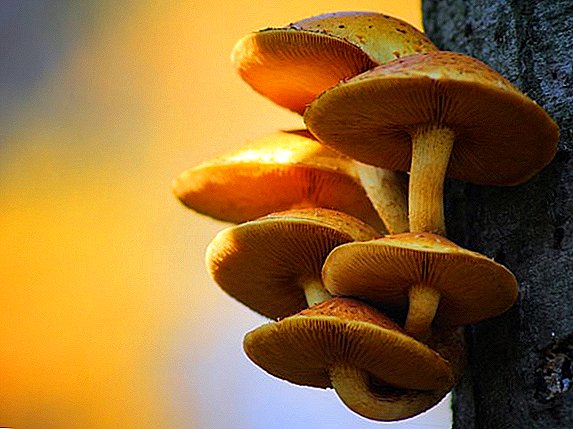 Mushroom pickers are not rarely found mushrooms that grow on trees and stumps. However, as a rule, they do not pay attention to them, because they consider them inedible, or simply do not want to get involved with unfamiliar instances. Really, there are few edible ones, and tasty and nourishing - and even less. Nevertheless, it is useful to learn more about them. What we propose to do by reading this article. In it you will find photos and names of mushrooms on the tree, and at the same time the answer to the question: are they edible or not.
Mushroom pickers are not rarely found mushrooms that grow on trees and stumps. However, as a rule, they do not pay attention to them, because they consider them inedible, or simply do not want to get involved with unfamiliar instances. Really, there are few edible ones, and tasty and nourishing - and even less. Nevertheless, it is useful to learn more about them. What we propose to do by reading this article. In it you will find photos and names of mushrooms on the tree, and at the same time the answer to the question: are they edible or not.
Is it possible to eat?
As we wrote above, among the mushrooms growing on trees and stumps, those that can be eaten are found. Although it should be noted that they are much smaller than among those that grow in the soil. The most famous among the fungi found on the trunks are the honey agarics. This is the popular name for the group of edible mushrooms, which belong to a variety of morphological groups. The mushroom was called - garland, because most often it grows on living or already inanimate wood, on stumps. 
Did you know? Mint is an important product for human health. So, it contains trace elements involved in blood formation. By consuming 100 grams of these mushrooms per day, a person will satisfy his daily need for such important elements as copper and zinc..The category of mushrooms includes quite a lot of different mushrooms. Also under them can be masked inedible specimens, which are called false honey mushrooms. Therefore, it is very important to know the characteristic differences between dangerous and non-dangerous fungi. Below we provide a photo and description of the mushrooms that grow on trees and are most common.
How not to make a mistake in choosing?
Among the mushrooms on wood, not only the mushrooms are caught, it is also tinder, oyster mushrooms, scales, and liverwort. They are edible, poisonous and curative. Let's get to know them closer. 
Edible
Not all of the mushrooms listed below are tasty and nutritious, however, they do not bring harm to health. Some of them are well known and popular among experienced mushroom pickers. Here is a list of edible mushrooms growing on trees, with photos and descriptions:
- Horned Oyster (Pleurotus cornucopiae). It has a hat in the shape of a horn or funnel. It is light, slightly gray in color. It has a diameter of 3-12 cm. The leg of the oyster mushroom is located in the center, covered with nazbegayuschimi plates, 2-6 cm long. The flesh of the oyster mushroom is white, fleshy, elastic. The mushroom has a slightly pronounced, almost imperceptible aroma and taste. Lives on deciduous crops from May to September.
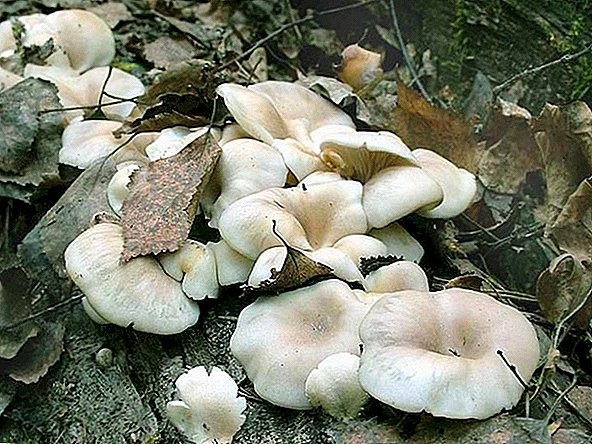
- Grifola curly (Grifola frondosa). It has other names: mushroom-ram, dancing mushroom. The copy is easily recognizable by a pseudochromatic splicing and a light stem. His flesh is white, fibrous. It has a pleasant taste and aroma. Fruits from June to October. Most common at the base of oaks and maples. May have a mass of up to 10 kg.
Without health risks, you can eat such edible mushrooms: aspen, black milk mushrooms, boletus, russula, volnushki, satanic mushroom, chanterelles, aspen, white mushrooms, champignons, boletus fungus, white fungus and honey agaric.
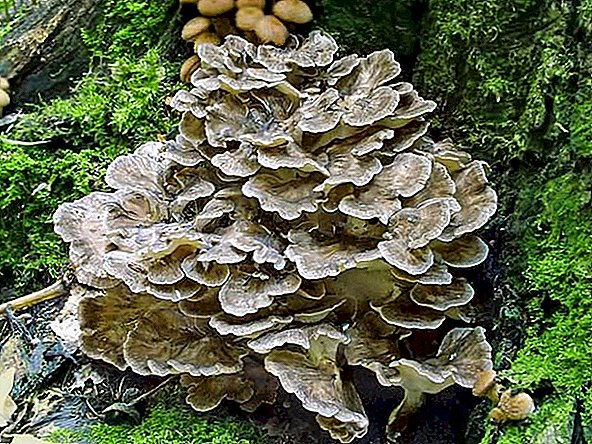
- Winter hull (Flammulina velutipes).It has a convex brown cap and leg. The center of the fruiting body is darker. The foot is covered with fibers. Its diameter is from 2 to 10 cm. The leg is brown, about 7 cm long. The flesh is white, tasty and fragrant. It is most commonly found on deciduous hardwoods, dried willows and poplars. From autumn to spring it grows in groups, it can even occur under snow.

- Summer sandstone (Kuehneromyces mutabilis).Resident of deciduous forests. Fruits from April to November. It has a small cap - its average diameter is 6 cm. Like all of them again, it is convex in youth, and by old age it is flattened and flattened. In color - brown or yellow. The leg of this stew is smooth, 7 cm high. The flesh is yellowish, refined, with a mild flavor.
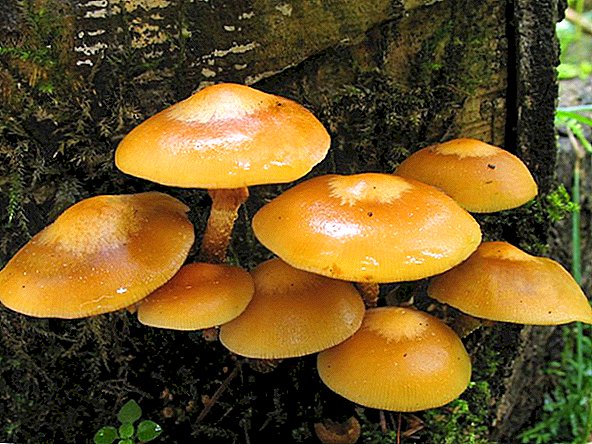
- Autumn honeycomb (Armillaria mellea).Hat with a diameter of 17 cm. Painted in different shades of green and brown. The legs of the autumn experience of 10 cm long, light brown, covered with scales. The flesh is dense, white. Mushroom is delicious, has a pleasant aroma. Most often they can be seen on the stumps of such trees: aspen, alder, birch, elm.

Important! Many of the honey agarics have dangerous twins. The main difference, by which it is possible to distinguish between mushrooms and false specimens, is the presence of a ring on the edible mushrooms on the stem under the cap.
- Liver ordinary (Fistulina hepatica). The specimen is named because it resembles a piece of liver in a section. Has a semicircular brown, slightly red or brown cap 10-30 cm in circumference. It grows on a short side leg. The flesh is reddish, fleshy. The fruit body is sour in taste and fruity in smell. Prefers to grow on living trees. Usually settled on oak, chestnut. Rarely can it be seen on leafy plants. Mushroom can be found from late summer to autumn.
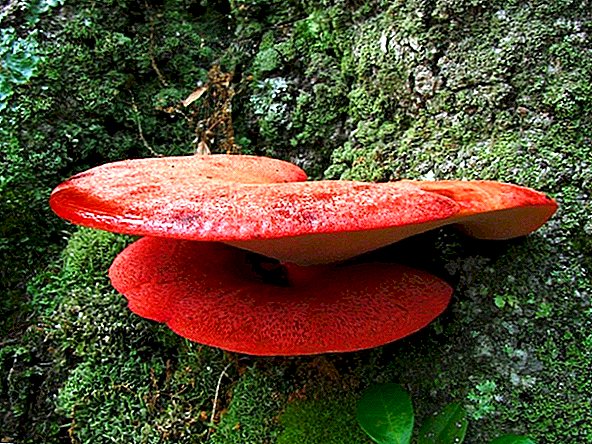
- Common tiger leaf tiger (Lentinus tigrinus). The hat of this specimen grows to 4-8 cm. It is painted in light shades - it can be white, yellowish, nutty. Covered with scales of dark brown or black. Leg bent, 3-8 cm in length. The flesh is tough, does not have a special smell and taste. It is characterized by a high content of protein. Collection period - from mid-summer to autumn. It grows on hardwood.

- Cellular polyporus (Polyporus alveolaris).His hat is oval or semi-circular. It has a yellow color with a reddish tinge. Covered with small scales. Reaches a diameter of 2-8 cm. Leg - white, short (about 10 mm), located on the side. Some specimens generally grow without legs. The flesh is tough, white. Her smell and taste are inexpressive. Fruits on deciduous crops from April to August.
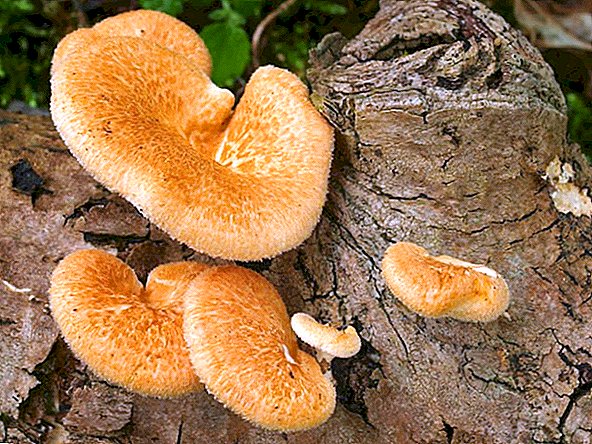
- Polyporum scaly (Polyporus squamosus) is one of the popular mushrooms growing on trees - you can see it in the photo and in the description. This specimen grows with a leathery yellow hat dotted with brown scales. Its size is about 30 cm. The leg is also covered with scales, brown. It reaches a length of 10 cm. The pulp is characterized by density and juiciness, with a rich, pleasant mushroom flavor. Tinder is edible only in its young form, it is too adult, it will already have a hard flesh. The period of its fruiting falls on the spring and summer. Usually grows in parks and deciduous forests. Likes to settle on elms.
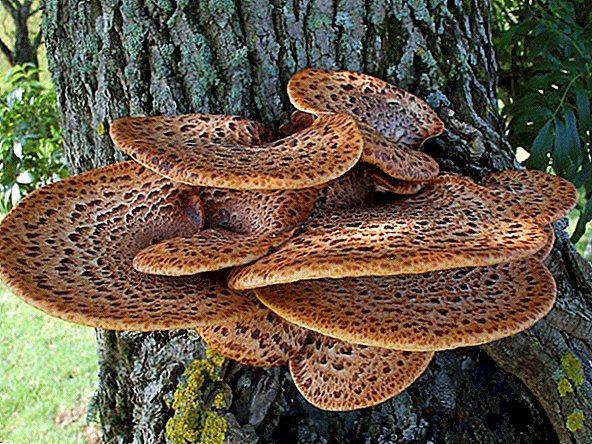
- Tinder is sulfur-yellow (Laetiporus sulphureus). The people nicknamed chicken. It grows with a yellowish cap in the form of a drop of 10-40 cm in diameter. Its leg is poorly expressed, just like the cap, has a yellowish tint. The flesh is firm and juicy. It grows on various deciduous and coniferous crops, it can affect fruit trees. Fruits in late spring to early autumn.

Important! Since mushrooms are heavy food for the human digestive tract, they should not be eaten at night. Also, they do not need to feed children under five. Before use, any mushrooms must be boiled for at least 20 minutes.
Poisonous
Among the parasitic fungi on trees, more, of course, inedible, and even those that can cause serious harm to the human body. Here is a list of the most common inedible mushrooms growing on trees, with photos and descriptions:
- Ganoderma south (Ganoderma australe). The cap of this specimen is flat and very large - up to 40 cm in diameter and up to 13 cm in thickness. It has brownish, gray, brown shades. Feet almost there. The flesh of the fruit body is soft, brown or reddish. Likes to settle in poplars, oaks and lindens.

Mushrooms such as pale toadstool, piglet, and speculum are not recommended for eating, as they are poisonous.
- Ischnoderma resinous (Ischnoderma resinosum). The fruit body of this fungus is up to 20 cm in diameter. It has a bronze, brown, reddish color. When the ischederma is actively growing, drops of red liquid are released on the cap. The pulp of the fungus is juicy, white. Ishnoderma occurs from August to October in deciduous forests (most often on beech, birch, linden). Causes white rot in fir.
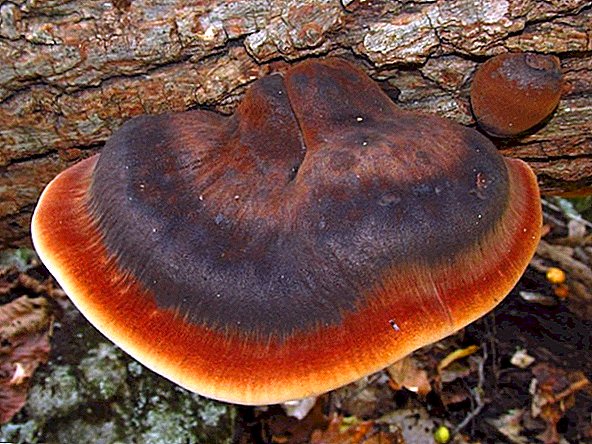
- Piptoporus oak (Piptoporus quercinus). It is characterized by a large fruit body oval or fan-shaped 10-15 cm in diameter with a velvety surface. Coloring can be white, brown, yellowish. It grows on living plants, most often on oaks.
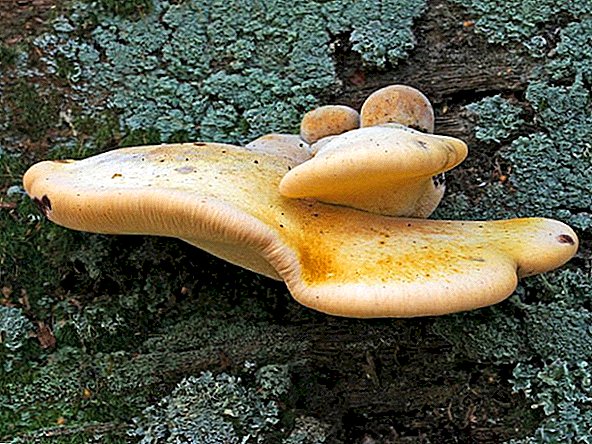
- Postia knitting (Postia stiptica).This instance is very common, it can be recognized by the white fruit body of various shapes. Young mushrooms are covered with drops of liquid. They have a juicy and fleshy flesh with a bitter taste. Mostly grow on conifers.

- Trametes fluffy (Trametes pubescens). Hats grow 10 cm in circumference. The surface of their gray with different shades. The flesh is white and leathery. Most often found on stumps and deadwood. She likes to settle on birches and conifers.
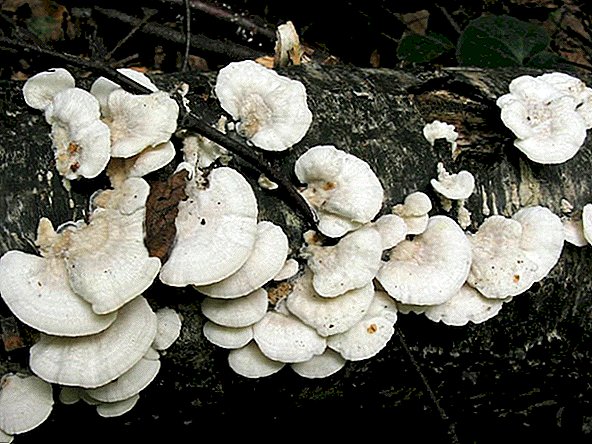
Important! Be careful - poisonous mushrooms can be as attractive in appearance and very fragrant, as well as edible.
Medicinal
Some mushrooms, growing together with a tree, form fruit bodies that have healing properties. Of these, folk healers make medicines. These include, for example, mushrooms growing on trees, with photos and names of which you can see below.
- Larch sponge (Fomitopsis officinalis). Its other name is agaricus. The fruit bodies of the fungus resemble the hoof, and can also be oblong-cylindrical. Reach mass up to 10 kg. The color is white, grayish-white, pale yellow. Grow on hvoynikov, most often on larch. Funds based on the fungus weaken, stop the blood, act as a sedative, have a slight hypnotic effect. Also used to reduce sweating.

- Sterile lacquered (Ganoderma lucidum). Better known as Reishi or Lingzhi. It has an ovoid or kidney-shaped cap with a smooth shiny skin of various colors: red, brown, purple, black. The flesh is ocher, tasteless and odorless. It mainly grows on dead deciduous wood, most often on stumps. Funds based on the fungus have antitumor, immunomoduliruyuschee effect. Used to improve blood circulation, metabolism, normalize blood pressure.

- Polypore Slanted (Inonotus obliquus), also known as chaga or birch mushroom. The fruit body grows in diameter from 5 to 40 cm. Has the shape of a growth of irregular shape. It happens in black. Covered with many small cracks. Usually lives on birch trees, but can also affect alder, maple, mountain ash, elm. Means based on oblique tinder are used with anti-tumor and anti-gastric purposes. Possess antimicrobial, antispasmodic, diuretic action.
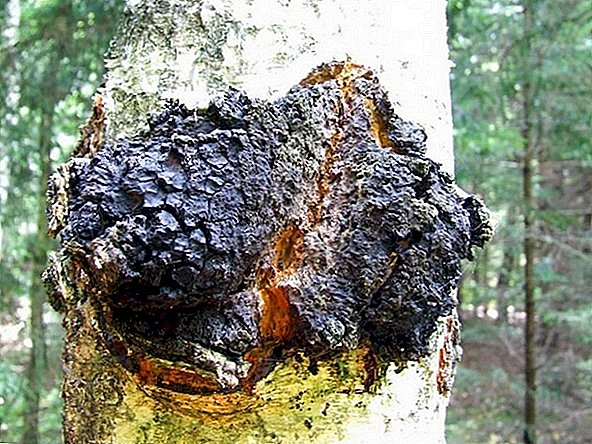
Did you know? Mushrooms contain more iron, phosphorus and calcium than any type of meat, and also 5-10 times more vitamin B3 than in greens and vegetables.
Using stumps to grow mushrooms
Stumps can be used for growing oyster mushrooms. This is easy to do, for example, at the dacha. To do this, you need a shady area or a room and a few stumps of hardwood (birch, aspen, apple, pear, acacia, poplar). Coniferous crops are not suitable for these purposes.
Stumps should not be old, ideal if they are freshly sawn. Dry need to soak for several days in water. Their sizes do not play a fundamental difference. Convenient segments with a diameter of 15 to 40 cm and a height of 40 to 50 cm. 
Cultivation of oyster mushrooms can be carried out both in open areas and indoors. If you plan to place stumps on the street, then the place should be in the shade and well ventilated. At temperatures below + 20 ° C agrofiber shelter is required. The best time for landing is April-May and August-September. Mycelium germinates within three months.
Exists several ways of laying logs. In each of them, you will need to dig a ditch at least 30 cm deep and wide, corresponding to the diameter of wooden blanks. If there are supports under the logs, you can not dig the earth, and place the stumps on its surface.
There are also several ways of inserting the mycelium into the stump - for example, by drilling holes, by cutting off the upper part, by building a pyramid of chocks with several layers of mycelium, etc. 
In winter, stumps will need to be brought into the room or covered with straw, agrofibre.
Important! An important condition for growing oyster mushrooms in an open area is the regular wetting of the soil around the stumps. The drip irrigation system is best suited for this purpose.When growing oyster mushrooms in the room you need it sanitized. For example, you can use a 4 percent solution of lime. After disinfection, the room will need to be closed for 48 hours and then well ventilated while there is no smell in it. The room must be ventilated, lighting, maintain the required temperature (+ 15 ° C).

It is most convenient to put logs after sowing with mycelium in the basement or shed horizontally, on top of each other. From above they are covered with sacking or perforated film.
With the vertical installation of logs they make columns and fall asleep with straw, sawdust. From the sides of the column is covered with a film or burlap.
Indoor air must be constantly humid. Frequent airing is mandatory.
In May, the stumps can be transplanted into the ground in the open.
The influence of fungi on the bark of trees
Mushrooms have a devastating effect on trees. It concerns both the bark and its roots. Usually, fruit bodies are formed on old, sick, damaged, insect-infected trunks. They can affect both forest plants and fruit crops. Often provoke the development of various rot, other diseases. As a result, the tree can completely die.
But some of the wood fungi, such as tinder, are called forest nurses because they contribute to the decomposition of old and diseased wood, enriching the soil with nutrients.
Mushroom pickers, conducting a "quiet hunt," most often look intently at their feet, looking for the desired prey among the grass. However, some of the mushrooms prefer to grow on tree trunks and roots. And among such mushrooms you can find quite tasty and fragrant specimens suitable for cooking various dishes. If you don’t have a forest full of mushrooms, you can grow them yourself, using newly cut tree stumps.




















